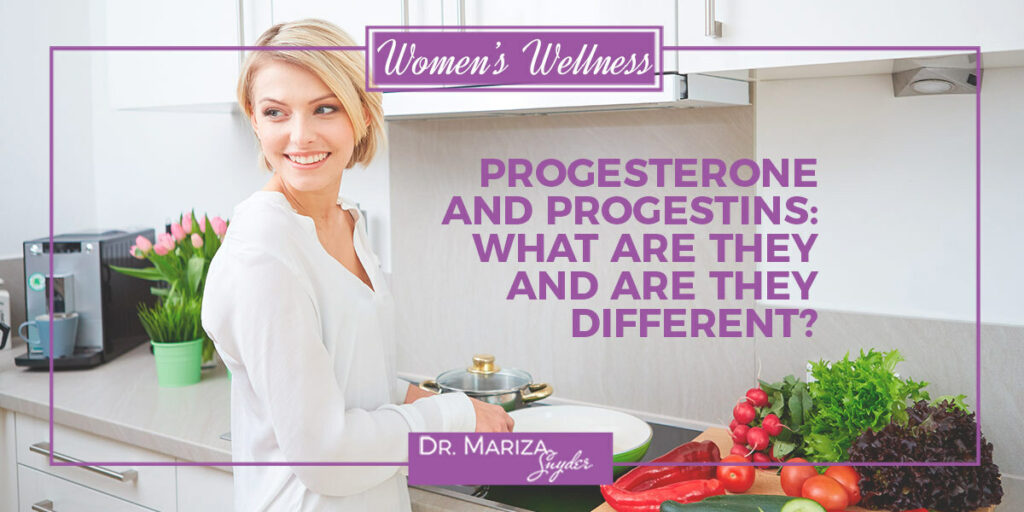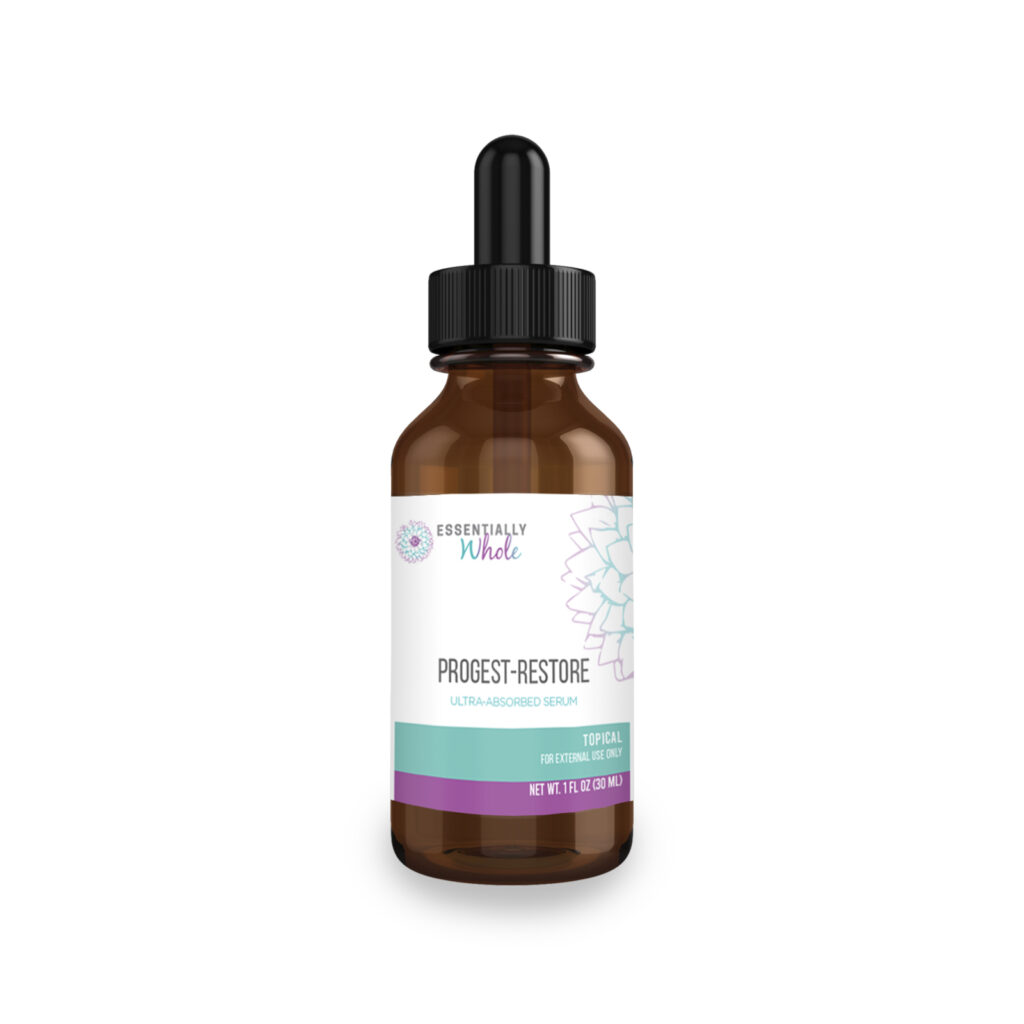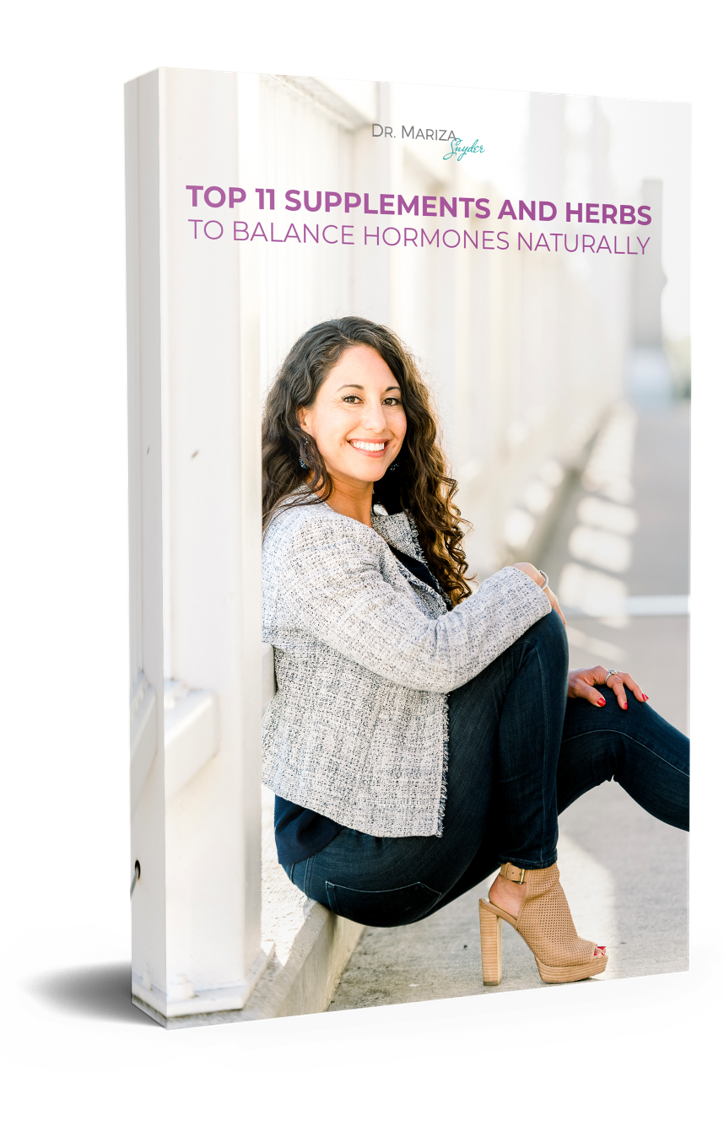
When it comes to your health, you want the food you consume and the medications or supplements you take to help your body function at its most optimal level.
So it’s important to know the purpose and possible side effects of what you take.
But sometimes, it is so confusing. Medical terminology can feel like another language, so you rely on your medical team to get it right.
Unfortunately, the difference between progesterone and progestins can be difficult for even doctors to keep straight.
Although the names of these two hormones sound very similar, they are not the same. The main thing to remember is that progesterone is produced naturally by your body, and progestin is synthetic.
Even though progestin can cause similar responses in your body, it also carries a higher risk of negative side effects.
WHAT IS PROGESTERONE AND WHY IS IT IMPORTANT?
Progesterone is a calming steroid hormone with an important job. It regulates the activity of the female reproductive system by beginning the menstrual cycle and maintaining a healthy pregnancy.
The progesterone production process begins with the pituitary gland. The pituitary gland produces Luteinising Hormone (LH), which plays an important role in ovulation.
It is during ovulation that the corpus luteum forms. Its purpose is to help you maintain a healthy pregnancy by ensuring your uterus is ready to support a fetus. It does this by increasing the size and increasing the lining of your uterus. It also provides enough oxygen and blood for the fetus. (1)
The corpus luteum is no longer needed if no pregnancy develops, so you shed your uterine lining.
But this isn’t progesterone’s only job. It also provides other health benefits. There is some evidence that it could support cardiovascular health by lowering blood pressure and widening blood vessels. (2)
Additionally, it stimulates hair growth, helps with sleep, and reduces the risk of breast cancer.
HOW YOUR PROGESTERONE CHANGES IN PERIMENOPAUSE
As you age, your ovaries begin to decline in functionality. This natural aging process leads to a decrease in progesterone levels.
Usually, progesterone levels help to keep estrogen levels balanced in the body. But with lower progesterone levels, estrogen levels begin to bounce up and down.
With lower progesterone and fluctuating estrogen levels, you begin experiencing symptoms such as hot flashes, night sweats, vaginal dryness, headaches, and mood swings.
As progesterone levels continue to decline and estrogen levels go unchecked, you end up with estrogen dominance.
WHY PROGESTINS ARE DANGEROUS
Progestins are synthetic versions of progesterone found in contraceptives. They are dangerous because, although progestins also affect ovulation and prepare the uterine lining for pregnancy, it is more structurally similar to testosterone than progesterone.
This difference means they have more side effects. They can cause health problems such as high blood pressure, hair loss, anxiety, depression, and increased cancer risk. (3)
HOW TO TELL IF YOU HAVE HIGH-QUALITY PROGESTERONE
The best form of progesterone is the one created by your body. But sometimes, for various reasons, we need a supplement.
If you and your practitioner have determined that is the best path for you, you want to know you are getting a high-quality supplement.
When looking for a supplement, make sure it is all-natural. Natural progesterone for supplements is derived from soybeans and yam roots.
This progesterone has the same chemical structure as the progesterone created by your body. (4) This means these hormones are bio-identical.
WAYS TO SUPPORT NATURAL PROGESTERONE PRODUCTION
As mentioned above, the best form of progesterone is the one created by your body, so let’s look at some ways you can boost your body’s progesterone production.
Foods
You can think of food as the foundation for good health. What you eat influences how well your body functions. When your body works well, it’s easier for it to produce progesterone.
You want to make sure you are building the best foundation possible. So here are some tips to help you create that solid foundation:
- Choose organic foods when you can. By eating organic foods, you avoid any added hormones that could increase your body’s estrogen level.
- Include herbs in your diet. Historically, herbs have been used to support the female reproductive system, including to boost progesterone production.
- Make high-fiber foods a priority. As with eating non-organic foods, not eating enough fiber can upset the hormonal balance in your body, leading to estrogen dominance. The easiest way to effortlessly increase your daily fiber intake is with my Pure Daily Fiber supplement.
- Eat foods rich in magnesium such as fish, nuts, pumpkin seeds, brown rice, and dark chocolate. Magnesium helps regulate the pituitary gland where LH is produced. While getting magnesium through food is helpful, it is virtually impossible to get all the magnesium you need from food, unfortunately. That’s why I always recommend that women include a high-quality magnesium supplement in their daily regimen. Check out my recommendation here.
- Eat walnuts, poultry, bananas, leafy greens, and beans. These foods are high in vitamin B6, and this vitamin assists the liver with breaking down estrogen. This breakdown, in turn, helps your body achieve the important hormonal balance between estrogen and progesterone.
- Include zinc in your diet by consuming shellfish, chickpeas, and lean red meats. Zinc supports the important functions of the pituitary gland in the hormone regulation of your body.
- Eat your oranges. Vitamin C increases progesterone levels and is also found in citrus fruits, tomatoes, strawberries, brussel sprouts, and tomatoes. If you’re struggling to get enough of this vitamin, my orange flavored Vitamin C Boost is a simple and delicious way to boost your immune system and increase progesterone.
Adrenal support
You need dehydroepiandrosterone (DHEA) for your body to produce progesterone. Your adrenal glands create DHEA, and adrenals that are not working as they should may reduce your levels of DHEA.
To support optimal adrenal function, reduce your consumption of coffee and alcohol, maintain healthy sleeping patterns and circadian rhythms, and drink nettle tea. If your adrenals need extra support, Adrenal Love is my go-to supplement blend that will help you prevent any more harm from stress.
Stress Reduction
Reducing stress can feel impossible when you’re balancing so many different roles. However, there are a few simple things you can do to keep your stress levels in check.
One effective method of reducing stress is by focusing on your breath. This can be done through meditation or yoga.
A regular exercise routine is also beneficial. It helps to clear your mind, so you are better equipped to deal with life’s daily struggles.
Using essential oils can be an easy but effective way to manage stress. Lavender is well-known for its calming effect. Other calming essential oils are Frankincense, Bergamot, and Vetiver.
PROGEST-RESTORE
If you need a progesterone supplement to address menopause symptoms or have a progesterone deficiency and want a supplement, make it a priority to make sure you are getting a high-quality form of it.
I’ve designed Progest-Restore for you. This is an all-natural supplement that works with your body making it easy to use, helping you get your progesterone levels back to where they should be.
References:



Can you recommend how to use progesterone? Daily. Certain times during your cycle?
Hi Erica! It’s always best to get specific instructions from your primary doctor. 🙂
What about plant progesterone like Wild Yam root?
Hi Debbie! My Progest-Restore is just that, it’s amazing! https://store.drmariza.com/products/progest-restore?_pos=1&_sid=2420cf65f&_ss=r